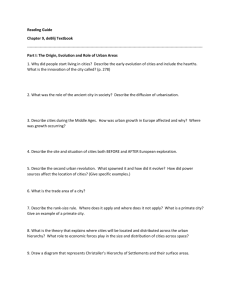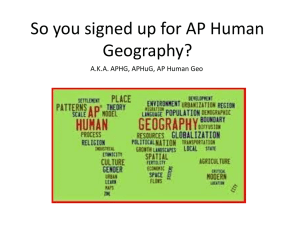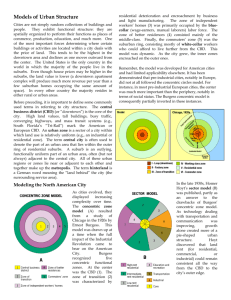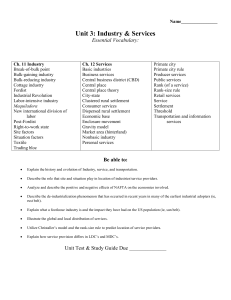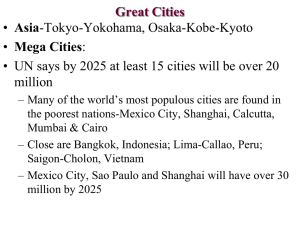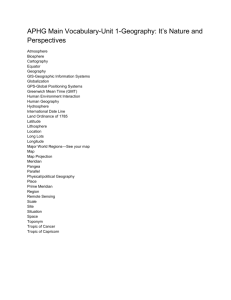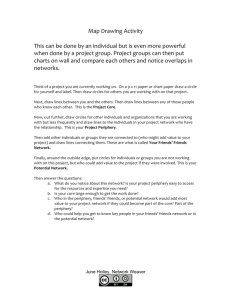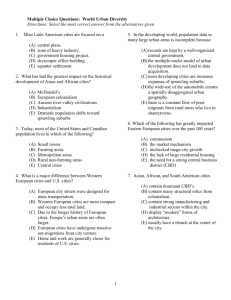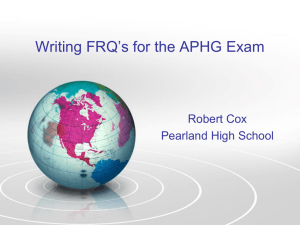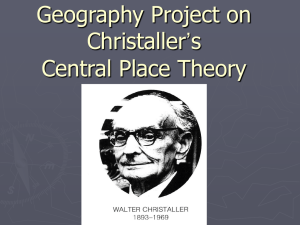Unit 7 Reading Guide - Madison County Schools
advertisement
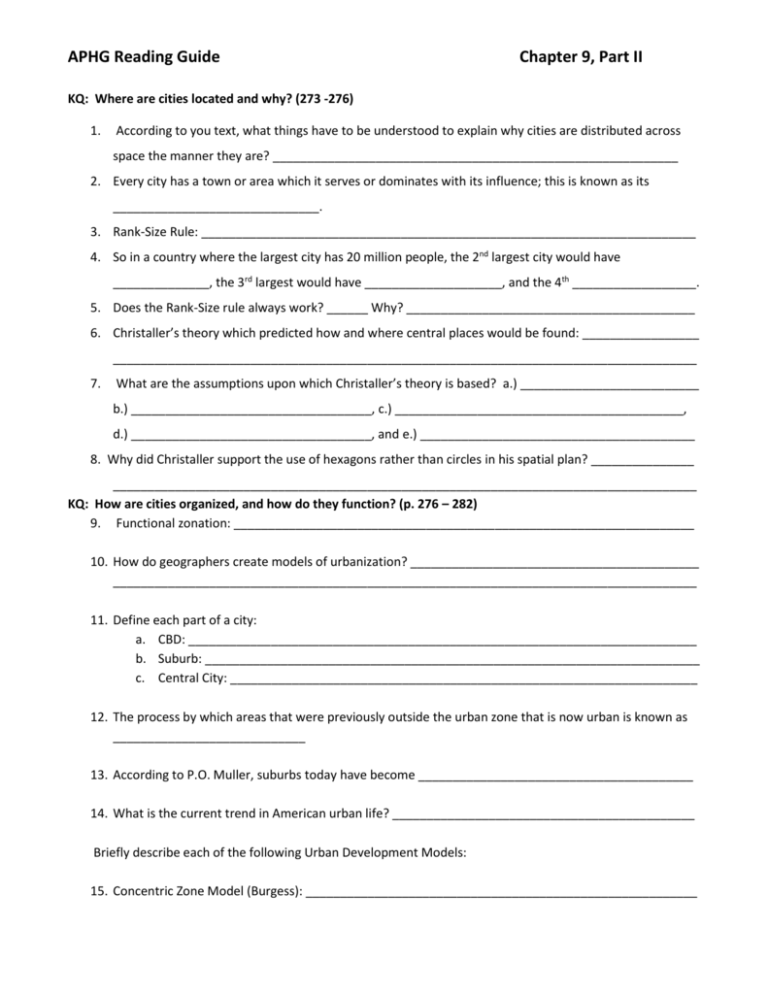
APHG Reading Guide Chapter 9, Part II KQ: Where are cities located and why? (273 -276) 1. According to you text, what things have to be understood to explain why cities are distributed across space the manner they are? ___________________________________________________________ 2. Every city has a town or area which it serves or dominates with its influence; this is known as its ______________________________. 3. Rank-Size Rule: ________________________________________________________________________ 4. So in a country where the largest city has 20 million people, the 2nd largest city would have ______________, the 3rd largest would have ____________________, and the 4th __________________. 5. Does the Rank-Size rule always work? ______ Why? __________________________________________ 6. Christaller’s theory which predicted how and where central places would be found: _________________ _____________________________________________________________________________________ 7. What are the assumptions upon which Christaller’s theory is based? a.) __________________________ b.) ___________________________________, c.) __________________________________________, d.) ___________________________________, and e.) ________________________________________ 8. Why did Christaller support the use of hexagons rather than circles in his spatial plan? _______________ _____________________________________________________________________________________ KQ: How are cities organized, and how do they function? (p. 276 – 282) 9. Functional zonation: ___________________________________________________________________ 10. How do geographers create models of urbanization? __________________________________________ _____________________________________________________________________________________ 11. Define each part of a city: a. CBD: __________________________________________________________________________ b. Suburb: ________________________________________________________________________ c. Central City: ____________________________________________________________________ 12. The process by which areas that were previously outside the urban zone that is now urban is known as ____________________________ 13. According to P.O. Muller, suburbs today have become ________________________________________ 14. What is the current trend in American urban life? ____________________________________________ Briefly describe each of the following Urban Development Models: 15. Concentric Zone Model (Burgess): _________________________________________________________ APHG Reading Guide Chapter 9, Part II 16. Sector Model (Hoyt): ___________________________________________________________________ 17. Multiple Nuclei (Harris / Ullman): _________________________________________________________ 18. Urban Realms: ________________________________________________________________________ 19. Latin American Model (Griffin / Ford): ______________________________________________________ a. Disamenity Sector: _______________________________________________________________ b. What is life like in the barrios or favelas? _____________________________________________ ______________________________________________________________________________ 20. The model of African cities is greatly influenced by the legacy of ___________________, which often moved economic activities and important governmental functions away from the traditional center. 21. How is the Colonial CBD different from the Traditional one? ___________________________________ ________________________________________________________________________________________ 22. South East Asian City (McGee): ___________________________________________________________ a. What is the focus of a SE Asian city? _______________________________________________ 23. Do models show us how or why the cities are organized the way they are? ________________________ KQ: How do people make cities? (p. 282 – 294) 24. Who plays a role in making cities? ________________________________________________________ 25. What are some markers you could see in a neighborhood that would tell you about that area? _______ _____________________________________________________________________________________ 26. Why are many of the world’s most populated cities found in the periphery? _______________________ _____________________________________________________________________________________ 27. Shantytowns: _________________________________________________________________________ 28. How do zoning laws impact the cultural landscape? ___________________________________________ 29. What role did realtors play in the making of a city? ___________________________________________ _____________________________________________________________________________________ 30. Redlining: ____________________________________________________________________________ 31. Blockbusting: _________________________________________________________________________ 32. Commercialization: _____________________________________________________________________ 33. Gentrification: _________________________________________________________________________ 34. How do governments influence the making of a city? __________________________________________ 35. “tear-downs”: _________________________________________________________________________ APHG Reading Guide Chapter 9, Part II 36. McMansions: _________________________________________________________________________ 37. The process of moving to ever further suburbs lead increasingly to a concept known as __________________________________. 38. What invention allowed urban sprawl to occur? __________________________ 39. Which area of the US experienced the most urban sprawl from the 1960’s to the 1990’s? ____________ 40. New Urbanism: ________________________________________________________________________ 41. What are the goals of the new cities planned using new urbanism? ______________________________ _____________________________________________________________________________________ 42. What are your thoughts on “manufactured cities” such as Celebration, FL? ________________________ _____________________________________________________________________________________ 43. Gated Communities: ____________________________________________________________________ 44. What are the advantages / disadvantages of a gated community? _______________________________ _____________________________________________________________________________________ 45. How were many of the ethnic neighborhoods in Europe developed? _____________________________ _____________________________________________________________________________________ 46. Why are European cities typically more compact than American cities? ___________________________ _____________________________________________________________________________________ 47. How is Calcutta different from many cities in the periphery? ____________________________________ 48. How do people living in the slums surrounding cities in the periphery survive? _____________________ _____________________________________________________________________________________ 49. Informal Economy: _____________________________________________________________________ KQ: What role do cities play in globalization? (p. 295 – 298) 50. World Cities: __________________________________________________________________________ a. Give three examples of world cities: _________________________________________________ 51. Primate City: __________________________________________________________________________ 52. Spaces of Consumption: _________________________________________________________________ 53. How has Times Square been transformed as a space of consumption? ____________________________ _____________________________________________________________________________________ 54. Prior to the revitalization of Times Square, it was home to illicit activities, today it is home to several large corporations and businesses, list some of these: _________________________________________ _____________________________________________________________________________________ _____________________________________________________________________________________ APHG Reading Guide Chapter 9, Part II
